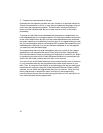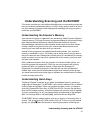22
channels, then press the GQK within 2 seconds. Systems can have up to 20
channel groups, and multiple channel groups can be assigned to the same GQK.
What is Scanning?
Unlike standard AM or FM radio stations, most two-way communications do not
transmit continuously. Your BCD996T scans programmed channels until it finds an
active frequency, then stops on that frequency and remains on that channel as
long as the transmission continues. When the transmission ends, the scanning
cycle resumes until the scanner receives another transmission.
What is Searching?
The BCD996T can search each of its 13 service search ranges and up to 10
custom search ranges to find active frequencies. This is different from scanning
because you are searching for frequencies that have not been programmed into
the scanner’s channels. You set the upper and the lower values of the range and
then the scanner searches for any active frequency within the limits you specify.
When the scanner finds an active frequency, it stops on that frequency as long as
the transmission lasts. If you think the frequency is interesting, you can program it
into the scanner’s memory. If not, you can continue to search.
What is CTCSS/DCS?
Your scanner can monitor systems using a Continuous Tone Coded Squelch
System (CTCSS) and Digital Coded Squelch (DCS) system, which allow squelch
to open only when the tone you have programmed with a specific frequency is
received along with a transmission.
CTCSS and DCS are sub-audible tone signaling systems sometimes referred to
as PL or DPL (Motorola’s trademarked terms for Private Line and Digital Private
Line respectively). CTCSS and DCS are used only for FM signals and are usually
associated with both amateur and commercial two-way frequencies. These
systems make use of a special sub-audible tone that accompanies a transmitted
signal.
CTCSS and DCS are used for many purposes. In many cases, CTCSS and DCS
are used to restrict access to a commercial repeater, so that only those units which
transmit the correct tone along with their signal can “talk” to the repeater.
CTCSS and DCS are also used in areas that receive interference where there are
several stations with output frequencies close to each other. When this occurs, you
might hear multiple communications on the same frequency. The stations might


















